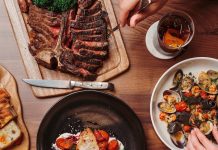Thanks to celebrity chefs like Roy Choi, who had the game-changing idea to put Korean barbecue in a taco, and the growing popularity of kimchee, the spicy cabbage condiment that can be seen on non-Korean foods such as french fries and burgers, Korean food is joining Chinese, Thai, or Vietnamese food in the culinary mainstream.
But Korean food is not just barbecue and kimchee. While metro Detroit isn’t home to a Koreatown like in New York or Los Angeles, there are excellent spots for authentic fare, such as Chung Ki Wa in Sterling Heights, which has the requisite barbecue but so much more.
Three signs that this is the real deal: 1. the banchan, 2. the crispy layer of rice in the bi bim bap, and 3. the soup and stew selection.
Banchan is the parade of side dishes/small plates that come out before the entrée or barbecue. Chung Ki Wa offers about five banchan and they can vary: with our barbecue we had bean sprouts, soy and sesame spinach, fish cake, and, of course, kimchee. Another day we had the fish cake and kimchee (a perfect blend of spicy, funky, and savory), but also some beans and broccoli and carrots.
The dol sot bi bim bap, which comes with your choice of bulgogi (beef marinated in a sweet sauce) or chicken, has all the right stuff such as cucumbers, carrots, and an egg. But the perfectly crisped layer of crunchy rice sticking to the bottom of the stone bowl is a sign of bi bim bap perfection.
The barbecue menu is vast, with no less than 14 choices of protein, including traditional choices such as bulgogi and kalbi (short rib that comes marinated or not marinated) as well as more adventurous options such as marinated and grilled beef chitterlings, grilled tripe, and beef tongue.
Other Asian cuisines are represented, such as Japanese, with sushi, sashimi, teriyaki, and tempura. We tried a Japanese-influenced spicy tuna salad, which was average, as well as the edamame. There’s also Chinese dishes, such as black bean noodles.
But don’t be tempted to stick to the familiar tempura, sushi roll, or barbecue. Step out of your comfort zone and place your trust in the servers, who are some of the sweetest and friendliest around; our server kept calling us “hon” and coming over to cook our meat for us, freeing us to dig in without becoming a slave to the grill (and someone always gets stuck cooking, inevitably making the communal experience less fun for them).
To truly understand the authenticity and mastery of the fare, look no further than the soups. Koreatown: A Cookbook author Matt Rodbard, who is from Kalamazoo co-wrote the book with Deuki Hong, told the Splendid Table podcast “soups are essential to understanding Korean food.”
Realizing I had closed myself off to 80 percent of the menu, on another visit I decided to order soup but was perplexed by the plethora of choices. The server steered me toward the yuk gae jang: hot and spicy beef broth with beef, egg drop, vegetables, and noodles. I would’ve never ordered it had I not asked her because I always order kalbi and bi bim bap, and I’m glad I trusted her when she said, “It’s the best.” The clear broth with speckles of spice was surprising with every slurp: familiar at first followed by a symphony of complexity.
There is a whole world to Korean food beyond barbecue. Explore it at Chung Ki Wa.
2101 15 Mile Rd., Sterling Heights; 586-264-4488. L & D Mon.-Sun. $20
|
| Ã˝ |
|








